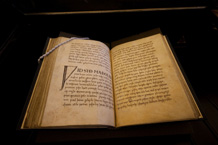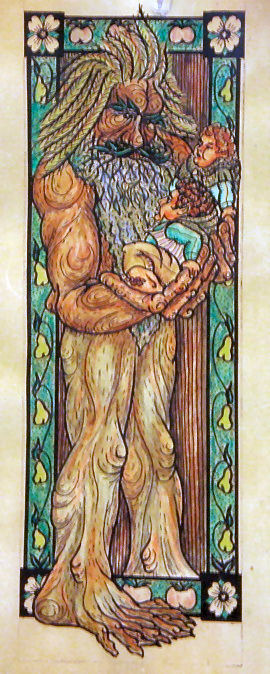Wrætlic is þes wealstan, wyrde gebræcon;
burgstede burston, brosnað enta geweorc.
Hrofas sind gehrorene, hreorge torras,
hrim geat torras berofen, hrim on lime,
scearde scurbeorge scorene, gedrorene,
ældo undereotone. Eorðgrap hafað
waldend wyrhtan forweorone, geleorene,
heardgripe hrusan, oþ hund cnea
werþeoda gewitan. Oft þæs wag gebad
ræghar ond readfah rice æfter oþrum,
ofstonden under stormum; steap geap gedreas.
Wunað giet se ...num geheapen,
fel on
grimme gegrunden
scan heo...
...g orþonc ærsceaft
...g lamrindum beag
mod mo... ...yne swiftne gebrægd
hwætred in hringas, hygerof gebond
weallwalan wirum wundrum togædre.
Beorht wæron burgræced, burnsele monige,
heah horngestreon, heresweg micel,
meodoheall monig mondreama full,
oþþæt þæt onwende wyrd seo swiþe.
Crungon walo wide, cwoman woldagas,
swylt eall fornom secgrofra wera;
wurdon hyra wigsteal westen staþolas,
brosnade burgsteall. Betend crungon
hergas to hrusan. Forþon þas hofu dreorgiað,
ond þæs teaforgeapa tigelum sceadeð
hrostbeages hrof. Hryre wong gecrong
gebrocen to beorgum, þær iu beorn monig
glædmod ond goldbeorht gleoma gefrætwed,
wlonc ond wingal wighyrstum scan;
seah on sinc, on sylfor, on searogimmas,
on ead, on æht, on eorcanstan,
on þas beorhtan burg bradan rices.
Stanhofu stodan, stream hate wearp
widan wylme; weal eall befeng
beorhtan bosme, þær þa baþu wæron,
hat on hreþre. þæt wæs hyðelic.
Leton þonne geotan
ofer harne stan hate streamas
un...
...þþæt hringmere hate
þær þa baþu wæron.
þonne is
...re; þæt is cynelic þing,
huse ...... burg....
| This masonry is wondrous; fates broke it
courtyard pavements were smashed; the work of giants is decaying.
Roofs are fallen, ruinous towers,
the frosty gate with frost on cement is ravaged,
chipped roofs are torn, fallen,
undermined by old age. The grasp of the earth possesses
the mighty builders, perished and fallen,
the hard grasp of earth, until a hundred generations
of people have departed. Often this wall,
lichen-grey and stained with red, experienced one reign after another,
remained standing under storms; the high wide gate has collapsed.
Still the masonry endures in winds cut down
persisted on__________________
fiercely sharpened________ _________
______________ she shone_________
_____________g skill ancient work_________
_____________g of crusts of mud turned away
spirit mo________yne put together keen-counselled
a quick design in rings, a most intelligent one bound
the wall with wire brace wondrously together.
Bright were the castle buildings, many the bathing-halls,
high the abundance of gables, great the noise of the multitude,
many a meadhall full of festivity,
until Fate the mighty changed that.
Far and wide the slain perished, days of pestilence came,
death took all the brave men away;
their places of war became deserted places,
the city decayed. The rebuilders perished,
the armies to earth. And so these buildings grow desolate,
and this red-curved roof parts from its tiles
of the ceiling-vault. The ruin has fallen to the ground
broken into mounds, where at one time many a warrior,
joyous and ornamented with gold-bright splendour,
proud and flushed with wine shone in war-trappings;
looked at treasure, at silver, at precious stones,
at wealth, at prosperity, at jewellery,
at this bright castle of a broad kingdom.
The stone buildings stood, a stream threw up heat
in wide surge; the wall enclosed all
in its bright bosom, where the baths were,
hot in the heart. That was convenient.
Then they let pour_______________
hot streams over grey stone.
un___________ _____________
until the ringed sea (circular pool?) hot
_____________where the baths were.
Then is_______________________
__________re, that is a noble thing,
to the house__________ castle_______
|






